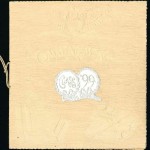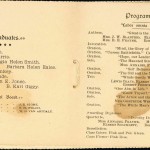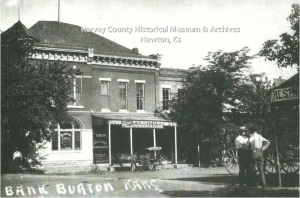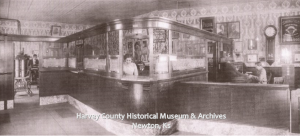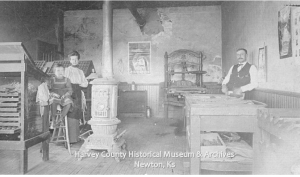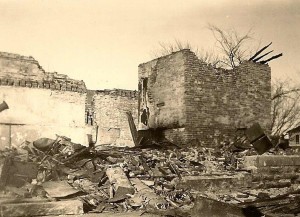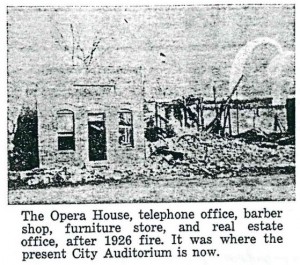by Kristine Schmucker, HCHM Curator
Once towns were established with business and services, Harvey County citizens began to think about the finer things in life. One measure of success was the ability to provide space for entertainment and the fine arts. For many prairie towns the opera house was a symbol of refinement. During the last decades of the 1800s, two Harvey County towns constructed an opera house. Newton’s Rasgdale was constructed in 1884-85 and at the same time, Burrton was also constructing a place for the community to gather for entertainment.
Built in 1885, the Burrton Opera House
“was known all over the country for the excellent stage plays presented. Large crowds climbed the long steep flight of wooden steps to see Grace George, Georgia Troubadours, Monara Minstrels and such epics as Uncle Tom’s Cabin and East Lynn.”
In 1910, the Cyclopedia of Kansas noted that Burrton had a population of 689. At that time the small community boasted two banks, two weekly newspapers, several churches, a public school, an opera house, and several “first class mercantile houses.” Services also included a post office with four rural routes and telegraph and telephone service. The thriving town made good use of its opera house.
Like the Ragsdale, the Burrton Opera House served more than one function. School activities, programs and graduations were held at in the auditorium.
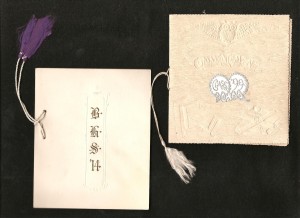
Two Burrton High School Graduation Programs from 1914 and 1899. the ceremonies were held at the Opera House. Programs courtesy Nancy Krehbiel.
1899 Burrton High School Graduation Program
- 1899 Burrton High Graduation Program, cover
- 1899 Burrton High Graduation Program front page.
- 1889 Burrton High High School Graduation Program.
Before radio or television, the Opera House was the place to gather on election night.
“Returns came in by wire to the depot and the operators took down the message. Teenage boys rode their bicycles to the depot, picked up the latest returns, rode furiously back the three blocks, charged wildly up the long flight of stairs and down to the stage, where the standings were read off by someone with a good strong voice.”
Claytie Hoskinson described the atmosphere at the Opera House on election night.
“On election evening we had an early supper and then everyone converged at the old “Opera House” to hear the returns. Upstairs there were two great pot bellied stoves, red hot with wood and coal fires and the whole place was surprisingly comfortable . . . There was entertainment but the big event was reading of the wires as they came from the depot. . . . It was terribly exciting, especially if your candidate was winning and we sat on the edge of our chairs and the battle raged back and forth.”
In addition, the building housed the Burrton State Bank and a furniture store.
Traveling shows would frequently stop in Burrton. Milburn Stone, Burrton native and actor, performed many times “under the canvass, in the old Opera House” during the early part of his career. He was with a traveling show known as the Wallace Bruce Players.
For several years the Burrton Opera House was also the site of an “Old Fiddler’s Contest.” In March 1916, fifteen people competed in the contest and a local man, James Kile, took third place. His prize was $4.00.
In 1926, the Burrton Opera House burned. Several other businesses were also affected including a furniture store, barber shop, telephone office, and the real estate office of Judge W.L.D. Daily.
Sources:
- Findley, Nedra & Paula Hoskinson. Burrton, Kansas Centennial: 1873-1973. HCHM Archives.
- HCHM Photo Archives.
- Nancy Krehbiel Personal Collection.
- http://burrtonkansas.com/history.htm
- http://www.burrtonhistory.com/index.php/galleries/83-downtown-burrton/73-the-sun-outdone-in-burrton-1888
- James J. Kile (1873-1947), Star Cemetery, Harvey County, KS, Find A Grave Memorial.
- Cyclopedia of Kansas, 1912, Burrton at http://ksgenweb.com/archives/1912/b/burrton.html, page 259 from volume I of Kansas: a cyclopedia of state history, embracing events, institutions, industries, counties, cities, towns, prominent persons, etc. … / with a supplementary volume devoted to selected personal history and reminiscence. Standard Pub. Co. Chicago : 1912. 3 v. in 4. : front., ill., ports.; 28 cm. Vols. I-II edited by Frank W. Blackmar. Transcribed May 2002 by Carolyn Ward.
- http://www.kshs.org/kansapedia/opera-houses/14232



